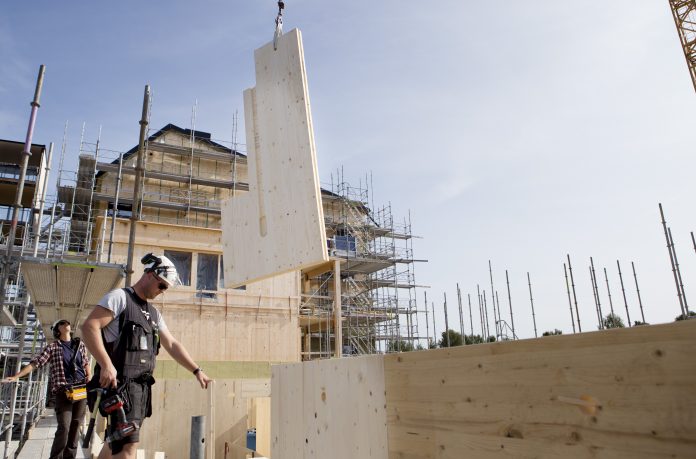Jeremy English, sales director for manufacturing at Södra Wood, Sweden’s largest forest-owner association, explores how timber can facilitate less expensive, more efficient and attractive construction
When a government department launches a white paper entitled Fixing Our Broken Housing Market, you know there’s something pretty serious afoot. The government’s Housing White Paper, published in February 2017, finally laid bare some uncomfortable new homes truths for all industry stakeholders.
We all, of course, know the problem well: The UK faces an unprecedented shortfall, and a historic backlog, of accessible new housing. But the question ‘what can we do to mitigate this shortfall?’ is more nuanced. To begin to understand the problem clearly, we need to consider that multiple factors are at play – not least considering how new homes can be constructed better.
Running the numbers
Originally, the government’s goal was to deliver one million dwellings by the end of 2020; that equates to around 200,000 new homes per annum. In 2016, this target rose to 300,000 new homes annually for the foreseeable future (Building More Homes Report 2016). The current Conservative government’s manifesto pledged to honour the one million target and to also “deliver half a million more by the end of 2022”.
More recently, in December 2018, parliament issued another sobering briefing. Tackling the Undersupply of Housing in England examines some of the key barriers and potential solutions to increasing housing stock in England. It also affirmed estimates that England needs between 240,000 and 340,000 new homes per year. Yet in 2017-18, the total housing stock in England increased by just 222,000 homes: Admittedly a 2% uplift on the previous year, but still an ongoing shortfall against the annual estimated need.
Driving a change
No matter how many new homes we build, if buyers can’t afford them, the problem just gets worse. Research from the Institute of Fiscal Studies suggests that currently, 40% of young adults cannot afford to buy one of the cheapest homes in their area. The proportion of 25 to 34-year-olds who own a house has dropped from 55% two decades ago to just 35% today.
Building homes faster and widening the range of construction methods is one way the industry can change this.
At the same time, the government and the housebuilding industry also face challenging environmental pressures. For instance, the Committee on Climate Change (CCC) reports that 18% of UK carbon emissions come from buildings – mostly homes – with a further 15% of emissions generated by electricity consumed in them. The ways that homes are constructed, the building fabric and materials used, and the energy efficiency of the completed dwelling are now more important than ever.
Timber construction is good. Sustainable timber construction is better
Building with high-quality, sustainably sourced timber can help combat all of the above issues. Light, versatile and sustainable, wood is both renewable and a carbon-neutral construction material.
Compared to brick and blockwork, timber construction is faster and cleaner. Even better, responsible forestry (such as that practised by Södra) ensures a sustainable source of material supply. A known, trusted provenance and slow growth cycle means all timber purchased is stronger, more durable, and has fewer knots and imperfections.
Efficient offsite manufacture
Offsite manufacture and modular construction are poised to turn UK housebuilding on its head. Fully finished, prefabricated timber frame building sections, typically with pre-insulated Structural Integrated Panels, are created offsite in a fabrication facility and shipped to the site on demand to be fixed together.
Modular homes not only cut construction time by up to half, they also require less labour and materials, which typically reduces cost. Because panels are factory-built, in dry conditions, quality control is exceptional. Since the structural element is renewable timber, not concrete, block or steel, the carbon footprint is dramatically reduced.
The government has already recognised the immense potential. In a recent Budget statement, Chancellor Phillip Hammond vowed to use state purchasing power to drive the adoption of this technology in 2019.
Lower embodied energy
Then there’s embodied energy. Timber offers the lowest embodied energy rating of any mainstream building material. For example, a wooden floor beam requires around 80 megajoules (mj) of energy per square metre of floor space and emits 4kg CO2. By comparison, a square metre of floor space supported by a steel beam requires 516mj and emits 40kg of CO2, while a concrete slab floor requires 290mj and emits 27kg of CO2.
Easy to work with
Unlike stone or steel-based materials, timber is light, versatile and is easy to handle, manoeuvre and install. Construction is typically faster, less expensive and less disruptive. In urban and brownfield developments, sites are usually quieter, calmer and cleaner.
Aesthetically pleasing
The UK needs to build attractive homes that people actually want to live in. The versatility and inherent natural beauty of timber speaks directly to this. Timber framing and cladding offers architects, developers and buyers free rein to design – or refine – new homes creatively and sympathetically – without breaking the bank or contradicting local planning requirements.
Timber naturally grows more slowly in colder climates, resulting in tighter growth-rings. This not only signifies stability and strength but also provides an additional design feature. It offers a wide range of aesthetics that give great design flexibility. It can vary in colours and texture, can be painted in any colour, waxed and varnished, carved, cut, glued and nailed or just left as it is. A timber framed building can be one of the most beautiful types of structure possible.
Timber can also be clad in external materials, allowing it to complement specific local regulations and planning requirements.
A better future – home grown
The construction sector has changed little for decades – but the time for complacency is gone. The government-commissioned Farmer report in 2016 concluded that, unless it changed radically, the British construction industry was “a dying patient”.
As the pressure to address the UK’s housing crisis rises, and margins become even tighter, developers and construction companies need to open their eyes to opportunities, efficiencies, quality improvements and savings of sustainable timber-based construction techniques.
Jeremy English
Sales Director, Manufacturing
Södra Wood
Tel: +44 (0)1285 646000
Twitter: Sodra
LinkedIn: Sodra














